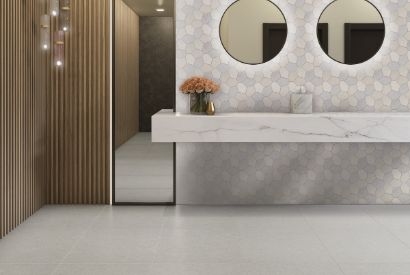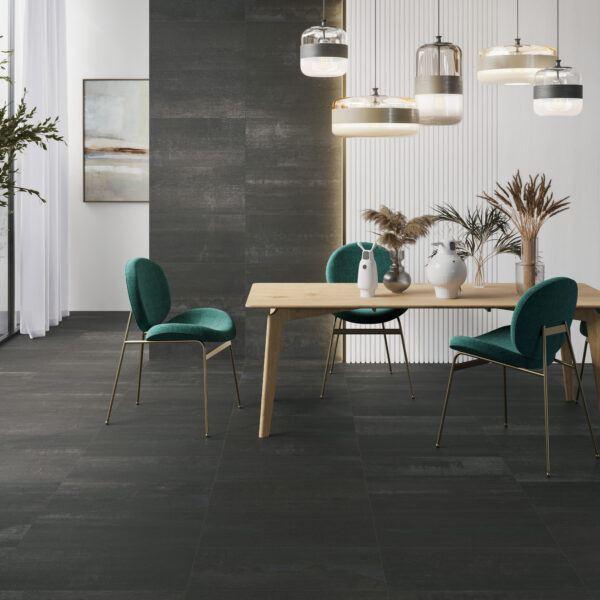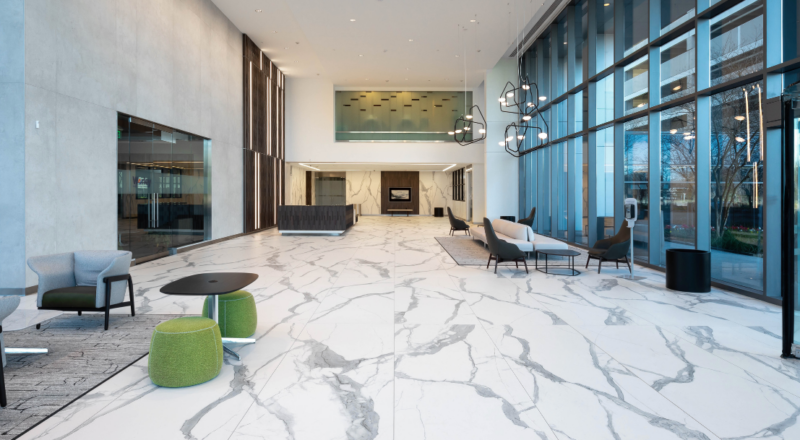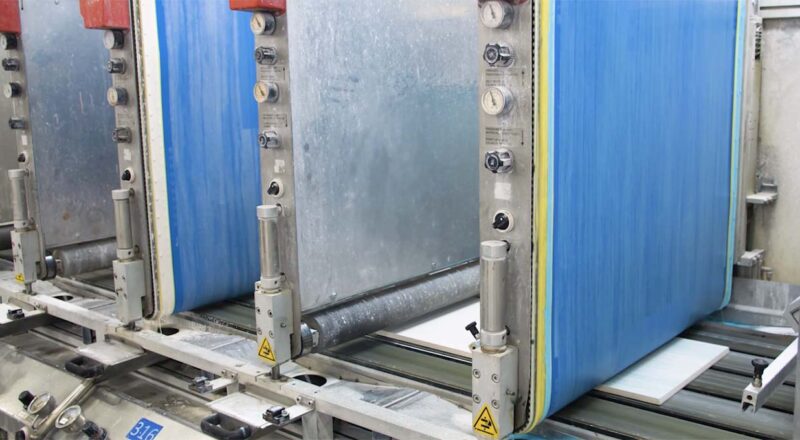What Does it Mean for a Hotel to Be Carbon Neutral?
 Crossville’s Carbon Neutral Native Metal in a hotel restroom
Crossville’s Carbon Neutral Native Metal in a hotel restroom
When a hotel states it is carbon neutral, that typically means it is taking the same amount of carbon dioxide out of the atmosphere as it emits. Hotels, as well as many other businesses, achieve carbon neutrality through carbon offsets. There are many ways hotels can create carbon offsets. For Instance, planting trees to capture the amount of carbon dioxide the hotel emits into the atmosphere is one way (Forests are considered one of the most significant carbon sinks, outsized only by the ocean).
Some carbon neutral hotels may not necessarily have green operations— they just purchase the offsets. Others become carbon neutral by combining being more efficient with purchasing offsets to make up for what they can or cannot do at that point in time.
While the purchase of carbon offsets is often used to compensate for emissions that cannot readily be eliminated, there are many ways hotels can become “greener” and reduce their carbon footprint as they work toward a more sustainable future with goals of carbon neutrality and even longer-term goals of net zero (having no greenhouse gas emissions).* It does cost hotels more to make changes as they head towards decarbonization, but as green strategies become more readily available, it’s becoming more commonplace, and thus less expensive, to make these changes.
Hoteliers can reduce their buildings’ environmental impact in many ways, but for new builds and renovations, selecting materials with low to no carbon emissions is an excellent foundation for decarbonization. Here’s a look at how hoteliers can reduce their hotel’s global warming potential (GWP) during construction or remodeling.
Surfacing Options
Porcelain tile is inherently green and a much better surfacing choice than environmentally unfriendly LVT or dirt-trapping carpet. Porcelain and ceramic tile naturally have the least lifecycle embodied carbon of any competitive floor covering. Porcelain flooring and wall coverings can easily last the life of the building, resulting in reduced overall carbon emissions from manufacturing, construction, demolition, and waste management. The leveling cement or mortars often used in a tile installation during a hotel renovation can have very low embodied carbon, resulting in a surfacing installation with much less embodied carbon than LVT or carpet.
Styrofoam Alternatives
Styrofoam is commonly used for insulating pipes for heat and moisture. It is almost indispensable in areas with extremely cold weather. During construction, styrofoam is often placed between concrete slabs to prevent moisture absorption. Styrofoam is uneconomical to recycle, highly flammable, and toxic. There are many green alternatives to styrofoam insulation, such as cellulose, recycled denim (yes, jeans!), sheep’s wool, insulated concrete, straw bales, and other manufactured eco-friendly alternatives.
Reuse
Reuse of existing structures, as well as materials, is the easiest way to reduce embodied carbon. The biggest offenders are concrete, steel, and aluminum, which account for 22% of all embodied CO2.
Precast Concrete Slabs
Unlike traditional concrete slabs, these slabs are formed at a manufacturing facility and shipped whole to the construction site. Concrete is an excellent way of controlling heat within a building, and the sustainability of precast concrete slabs is higher than many traditional concrete options, as the slabs often take much less energy to produce and assemble.
Recycled Plastic
Manufacturers are now using recycled plastic and other ground-up trash to produce concrete. This practice reduces greenhouse gas emissions and gives the plastic a new use instead of clogging landfills and contributing to plastic pollution. Reused plastic can also be used in products such as cable pipes, roofs, floors, PVC maintenance holes, and PVC windows.
Low Carbon and Carbon Neutral Building Materials
.jpg?lang=en-US) Crossville’s Carbon Neutral Civilzation in a hotel restroom
Crossville’s Carbon Neutral Civilzation in a hotel restroom
Industry-leading sustainable building rating systems now recognize whole-building life cycle assessment (LCA) as an essential metric for green building certification. Embodied carbon in building materials is a primary parameter measured in a whole-building LCA. Life cycle involves considering the environmental impacts from cradle to grave, including extraction, production, transportation, installation, maintenance, and end-of-life disposal.
Quantifying and disclosing the environmental and health effects of building products and materials is the first step toward reducing the impacts of embodied carbon, the carbon footprint of a material. Embodied carbon considers the greenhouse gasses (GHGs) emitted throughout the product’s supply chain, installation, use, replacement, and end-of-life disposal. Embodied carbon could represent 90% of total building-related emissions by 2050 if the industry keeps moving toward net-zero operating carbon but neglects to address embodied carbon.
In the past, architects had limited tools to lower the carbon footprint of their projects. Specifying materials with low carbon emissions was difficult, at best. Today, suppliers can offer material transparency in the form of EPDs (Environmental Product Declarations) which are technical documents that report on the carbon footprint of a product. These tools help architects and specifiers analyze the carbon emissions associated with procurement decisions.
How Crossville Tile Can Contribute to the Decarbonization of the Hospitality Industry

Porcelain and ceramic tile have long been the surfacing material of choice for the hospitality industry. Our porcelain tile, panels, and slabs are beautiful, inherently sustainable, enduring surfaces for every space of a hotel, from lobbies, public areas, corridors, elevator banks, and guest rooms to back-of-house and exterior spaces. We have EPDs and declare Labels for all tile we produce, porcelain panels, and porcelain slabs so that hospitality-focused architects, designers, and specifiers can clearly evaluate the sustainability of our products.
Porcelain Tile Life Cycle
Evaluating the life cycle of a building is crucial to understanding carbon reduction. Opting for materials with a lower environmental impact throughout their life cycle can reduce carbon emissions. Porcelain tile has an exceptional life cycle outperforming other floor finishes in cost per square foot over time with an estimated useful life of 75 years.
Porcelain Tile and Energy Reduction
Tile can reduce the energy needed for heating and cooling because of its exceptional thermal mass. Using light-colored porcelain tiles instead of traditional paving materials can lower an area’s heat absorption (or heat island effect).
Our Carbon Footprint Reduction Plan

Sustainability has always been at the core of our business, from sourcing to the final product stage. Crossville tile has long been a smart choice for projects prioritizing green design and sustainability. We’re now proud to take our sustainability efforts to the next level with our first carbon neutral porcelain tile collections. As with all Crossville manufactured products, these collections are carefully and responsibly made in the USA, yet, they represent a significant first step toward achieving our current short-term goal of 30% reduction of our tiles carbon footprint. You can learn more about our carbon reduction plan and our goals for a more sustainable future here.
Our Carbon Neutral Tile Collections
![]()
These new carbon neutral porcelain tile collections are especially suited to the hospitality industry. They are as beautiful as they are sustainable. Carbon-neutral products such as these tile collections can make a difference in a building’s embodied carbon (versus just the operational carbon).
Civilization

Inspired by basalt stone’s unique visuals and textures, our Civilization porcelain tile collection offers stunning visuals in light to dark colorways. The smooth, fine-grained stone naturally varies in color from light to dark, and Civilization follows suit with six natural incarnations of basalt featuring unique crystalline visuals and subtle movement found in these unique rock formations.
Native Metal

Our Native Metal collection captures the eternal luxury of patinaed minerals and ores in a refreshingly unique porcelain tile and resin line. The collection features six unique porcelain tiles finished with multiple glaze techniques. Native Metal offers carbon neutral field tiles, resin wall accents, and unique mosaic options formulated with real metals.
How You Can Help The Planet When You Travel
Consumers shouldn’t be depended upon to fix the hotel’s carbon emissions problem, but their choices of hotels can influence the industry. Guests are now more discerning about where they choose to stay, and eco-living is no longer just a trend; it’s a way of life for many guests. It would only make sense for hotels to pay attention to that. If you are traveling, scrutinize the hotel’s sustainability claims. You might want to think twice if a hotel claims to be eco-friendly, green, or carbon neutral but doesn’t explain how. Digging into what offsets the hotel uses or purchases might be more difficult, but it never hurts to ask.
*The Science Based Targets Initiative’s Corporate Net-Zero Standard states that net-zero must be achieved by abating at least 90% of emissions. The remaining 10% may be reduced through permanent removals in a target year.







